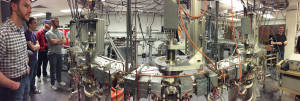This past Thursday, students from the Houghton College Physics Department had the chance to tour the radiation research facilities at the University of Maryland (UMD). The students were given cats-eye marbles that had been irradiated by the university’s gamma ray irradiator, turning them a pitch black. The color will slowly fade to clear glass over the course of a few decades.
 On the tour, students were given a look at a three-meter diameter rotating sphere filled with molten sodium metal for studying the development of magnetic fields of planets. They saw the linear accelerator (LINAC) and watched it deposit charged particles in pieces of acrylic. When the surface of these acrylic pieces was cracked, the particles surged towards this weak point, producing a lightning-like pattern called a Lichtenberg Figure.
On the tour, students were given a look at a three-meter diameter rotating sphere filled with molten sodium metal for studying the development of magnetic fields of planets. They saw the linear accelerator (LINAC) and watched it deposit charged particles in pieces of acrylic. When the surface of these acrylic pieces was cracked, the particles surged towards this weak point, producing a lightning-like pattern called a Lichtenberg Figure.
Students peered into a 6-inch diameter hole, at a glowing Cobalt-60 source beneath 15 ft of water. Gamma rays emitted from the source launch electrons that travel faster than the speed of light through water. They produce a visual “sonic boom” that emits an intense sky-blue glow. This process is called Cherenkov radiation. The source is used for many applications including artificially aging technological components and radiation hardness testing.
The next stop was UMD’s 250 kW nuclear reactor, MUTR. The reactor is used as a source of neutrons for experiments including cancer research in radiology, neutron detector development, and materials science. The core is housed in concrete and submerged beneath 17 ft of water, it is a research reactor and it does not produce electricity. It transfers its thermal power into its 6000 gallon natural water pool. The reactor utilizes the special TRIGA (Training, Research, and Isotopes by General Atomics) fuel that cannot meltdown because an increase in fuel temperature will reduce the fission reactions that limits the achievable power. This core glows even more blue than the cobalt source due to Cherenkov radiation.
The final stop on the trip was to the University of Maryland Electron Ring (UMER). This complex machine is at the “intensity frontier” of particle accelerator research. A low energy accelerator sends a high throughput of electrons into the ring. Experiments are performed on the self-interactions of the electrons in the ring as they accelerate in high densities.
